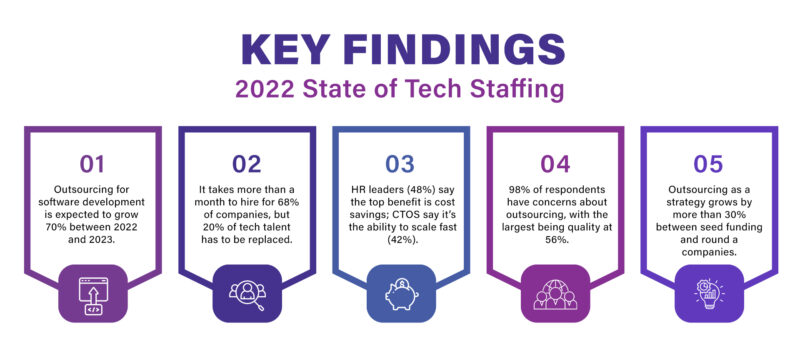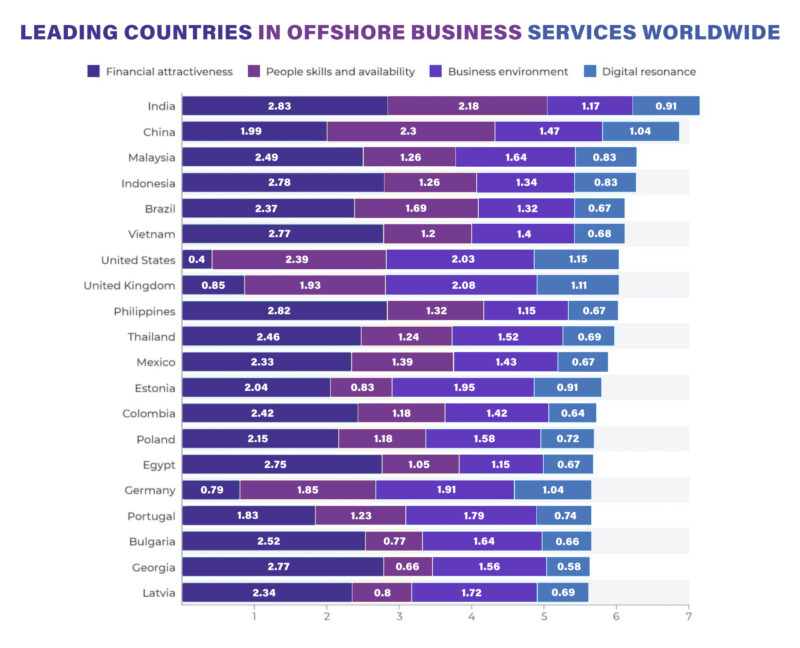
The symbiotic link between the tech industry and outsourcing has never been more critical in an era of rapid technological growth and unrelenting innovation. As technology advances at an unprecedented rate, the demand for specialized talents and scalable solutions has never been greater. Outsourcing has developed from a cost-cutting practice to a strategic need. It enables enterprises to tap into global talent, use cutting-edge expertise, and manage the complexities of the digital age with agility.
This comprehensive guide offers valuable insights and actionable strategies to help you leverage tech outsourcing’s full potential, from selecting the right outsourcing partners to mastering data security, and from achieving cost-efficiency to embracing the future trends reshaping the tech outsourcing landscape. Whether you are a tech-savvy expert or a newbie to the field, this article provides a roadmap in a world where outsourcing is essential to remain competitive and innovative in the tech industry.
Types of Tech Outsourcing
Software Development Outsourcing
Outsourcing software development services is a form of technology outsourcing in which businesses contract software application design, maintenance, and management to third-party service providers. This form of outsourcing includes a wide range of software-related tasks such as web development, mobile app development, custom software development projects, and others.
Infrastructure and Cloud Services
This type of tech outsourcing enables companies to offload the complexities of infrastructure management, ensuring scalability, reliability, and cost-effectiveness. Service providers such as Amazon Web Services (AWS), Microsoft Azure, and Google Cloud offer various infrastructure and cloud services, such as server provisioning, data storage, virtualization, and cloud security. Organizations gain access to cutting-edge technology without worrying about procurement and maintenance of expensive hardware, allowing them to focus on strategic initiatives.
Managed IT Services
Outsourcing Managed IT Services means partnering with external Managed Service Providers (MSPs) to manage and control an organization’s IT infrastructure and operations. This includes administration, cybersecurity, system monitoring, helpdesk support, and data backup. MSPs provide proactive IT management to help organizations prevent issues, improve security, and optimize IT performance.
Customer Support Outsourcing
Customer support outsourcing is a specialized form of outsourcing where businesses hire external call centers or customer service providers to handle customer inquiries, support requests, and issue resolutions. This can include phone support, live chat, email support, and ticket management. By outsourcing customer support, organizations can ensure customers receive quick and efficient assistance while reducing the operational costs of keeping an in-house customer support team.
Benefits and Risks of Tech Outsourcing
Benefits
Cost savings
Businesses can significantly reduce operational expenses by leveraging a global talent pool and tapping into countries with lower labor costs. This cost-effectiveness includes savings on infrastructure, administrative overhead, and equipment. Outsourcing offers various pricing models, allowing companies to tailor their spending to project requirements and budget constraints.
Access to specialized skills
One key benefit of outsourcing tech is gaining access to specialized skills that might not be readily available within your in-house team. Companies that outsource can access a global pool of experts with extensive knowledge and experience in a wide range of domains and technologies. This can be particularly advantageous when addressing complex or specialized projects, ensuring businesses can meet their objectives without requiring extensive in-house training or a lengthy hiring process.
Scalability and flexibility
Outsourcing allows businesses to quickly adjust to changing market demands by easily increasing or contracting their workforce to meet project demands without incurring the additional expenses and time associated with full-time hiring. This enables businesses to efficiently allocate resources as needed, allowing them to scale up during high-demand periods and down during low-demand periods. Outsourcing companies with various skill sets can manage these changes seamlessly, maintaining efficiency and keeping projects on track.
Focus on core competencies
One of the primary benefits of tech outsourcing is the ability to focus on core competencies while leveraging a dedicated team of experts. Companies can focus their resources, time, and expertise on the areas that define their core business and competitive edge by transferring non-core technical tasks to third-party service providers. This focused approach improves overall efficiency and enables a more strategic allocation of internal resources, resulting in increased innovation and performance.
Global market expansion
Outsourcing services like software development, customer support, or digital marketing allows businesses to tap into a global talent pool, gaining access to specialized skills and various perspectives that can help them enter foreign markets. Outsourcing companies often have a global presence or expertise in international markets, which can be beneficial in navigating local regulations and customer preferences.
Risks
Quality control issues
Maintaining the same quality and control over the end product can be difficult when businesses contract critical IT tasks to third-party service providers. Workplace cultural differences, communication barriers, or differences in standards and practices can all lead to inconsistencies in the final output. To reduce these risks, businesses should establish strict quality control mechanisms, maintain clear communication, and set well-defined goals and benchmarks.
Security and data privacy concerns
There is an inherent risk of data breaches, unauthorized access, or mishandling of confidential information when entrusting sensitive data and critical IT functions to an outsourcing company. Although ensuring the outsourcing partner has strong security measures is essential, vulnerabilities may still exist. When outsourcing, businesses may lose some control over their data and have challenges maintaining its integrity. Strict contractual agreements on data security, careful selection of outsourcing partners, continuous monitoring, and audits should be held to mitigate these risks.
Cultural and communication challenges
When businesses engage with offshore or remote teams, differences in language, work culture, and time zones can lead to misunderstandings and miscommunications, potentially compromising project outcomes. Collaborating with teams from different cultural backgrounds may be enriching and challenging because different work practices and communication styles may clash. To mitigate these, developing strong communication protocols, encouraging open dialogue, and promoting cultural awareness are critical.
Legal and regulatory risks
Businesses working with external service providers are often subject to different legal jurisdictions, which may result in complex legal issues. The risks include compliance with international, national, and industry-specific standards, and violations of these regulations may result in legal disputes, reputational damage, and financial penalties. To ensure that all legal and regulatory requirements are followed, businesses must thoroughly screen outsourcing providers and implement strong governance structures.
Dependence on external partners
While outsourcing might provide access to specialized expertise and cost-effective solutions, it also means giving up some control over key areas of the organization. Over-reliance on third-party providers can expose companies to disruptions such as vendor bankruptcy, abrupt service termination, or conflicts of interest. Companies must maintain a balanced approach, preserve in-house knowledge, and develop contingency plans to address any disruptions in the event of an outsourcing company’s failure or non-performance.
Key Players in Tech Outsourcing
Client or Customer Company
This is the company seeking to outsource tech services. They determine the scope of work, project requirements, and goals. They also establish the budget and expectations of the outsourcing partnership.
Outsourcing Service Providers
These are companies or firms that provide technology services to clients. They can be domestic or international service providers, ranging from specialized tech firms to general outsourcing companies.
Freelancers and Independent Contractors
Individual professionals or small teams who offer contract services for their technical expertise.
Consultants and Advisors
Individuals or organizations that offer expert advice on selecting the right outsourcing partner, developing strategies, and managing outsourcing projects successfully. Legal professionals specializing in outsourcing and technology offer guidance on contracts, data protection, intellectual property rights, and compliance with relevant laws.
Third-Party Quality Assurance and Testing Providers
Independent quality assurance and testing companies provide services to validate the quality and reliability of outsourced technology products. They check that software systems fulfill industry standards and use expectations.
The Global Landscape of Tech Outsourcing

Tech outsourcing is a dynamic and expanding industry with numerous destinations offering a diversified range of services to meet the demands of various businesses. India remains a global leader among the most popular tech outsourcing locations, famous for its large pool of highly skilled IT experts at affordable costs. Easter European countries such as Ukraine, Poland, and Romania are gaining popularity due to their strong technical skills and favorable time zones for Western businesses. The Asia-Pacific region has prominent outsourcing hubs in countries such as the Philippines, Vietnam, and Malaysia, known for their competent English-speaking workforce. Latin American countries like Mexico and Columbia are developing as competitive nearshore destinations, bridging cultural and language gaps.
Choosing the best tech outsourcing location requires a thorough assessment of several aspects. The solution’s cost-effectiveness must be matched with the quality and skill of the talent pool. Geographical proximity and time zone compatibility might affect real-time collaboration, while language proficiency and cultural alignment are necessary for effective communication. Compliance with data security and privacy regulations is critical, especially with the growing focus on cybersecurity. Finally, aligning these factors with your specific requirements and long-term goals is essential in making an informed decision when selecting a tech outsourcing destination.
How to Plan Your Tech Outsourcing Strategy
Identifying your company’s specific needs and objectives
Planning a tech outsourcing strategy begins with an extensive understanding of your company’s specific needs and objectives. Start by thoroughly reviewing your internal capabilities and identifying where outsourcing can add the most value. Defining your needs is essential, whether it’s a software development project, IT support, data analytics, or other tech-related services.
Setting clear objectives and goals
Set clear and attainable goals that align with your business goals. These goals should be specific, measurable, and time-bound and serve as a road map for your outsourcing strategy. For example, to enhance cost-efficiency, you could set a goal of reducing operational expenses by a specific percentage over a set period. By carefully laying the groundwork, you can be confident that your outsourcing plan is personalized to meet your specific needs and directly contributes to the success of your business.
Budgeting and cost considerations
A well-planned IT outsourcing strategy must include budgeting and cost considerations. Conduct a thorough financial analysis to understand the full costs of outsourcing, which go beyond the service fees to include setup charges, potential legal or compliance costs, and the expense of managing the outsourced partnership. Establish a reasonable budget aligned with the outsourcing strategy objectives and your company’s financial capabilities. Balancing cost savings and service quality is crucial, ensuring you don’t sacrifice the latter to save money.
Legal and security aspects in tech outsourcing
To ensure compliance with data protection laws, intellectual property rights, and contractual obligations, it’s critical to start by carefully evaluating the legal and regulatory landscape of both your home country and the outsourcing destination. Engage legal counsel with expertise in international outsourcing to draft robust contracts that clearly outline responsibilities, liabilities, and dispute resolution methods. Your outsourcing strategy will protect your company’s interests by carefully addressing legal and security issues.
Finding the Right Outsourcing Partner
Evaluating Potential Service Providers
1. Location and cultural fit
The geographical location of your outsourcing partner can affect time zones, language barriers, and travel accessibility, all of which can hinder communication and collaboration. Determining whether the partner’s location matches your business requirements is critical. Moreover, differences in work culture, communication styles, and business practices can lead to challenges and misunderstandings. Choose a partner whose work culture and beliefs align with your own, enabling a collaborative and productive working relationship.
2. Technical expertise and capabilities
Assessing the partner’s expertise in the technologies and domains relevant to your project or requirements is critical. Evaluate their track record of delivering similar solutions or services and inquire about their workforce’s skill sets and qualifications. A partner with a strong technical foundation and a proven track record is more likely to offer high-quality results and contribute significantly to your project’s success.
3. References and client testimonials
Requesting and examining references from the outsourcing partner provides you with useful information about their prior performance and reliability. Inquire with prior or present clients about their experiences, the quality of work produced, and the partner’s ability to meet project deadlines. Client testimonials can give extra assurance to the partner’s expertise and capabilities.
4. Pricing models and transparency
Assess the pricing structure the outsourcing partner offers to ensure that it aligns with your budget. Different pricing models, such as fixed price, time and materials, or outcome-based, offer different advantages and risks, so choose the one that best fits your project. Clear and transparent communication about costs and any potential changes during the project is essential for building trust and preventing disputes.
Request for Proposal (RFP) Process
It entails creating a detailed document outlining your project’s requirements, expectations, and evaluation criteria. A well-structured RFP acts as a road map for potential outsourcing partners, assisting them in understanding your requirements and enabling you to effectively compare their proposals. The project scope, objectives, technical requirements, timetables, budget constraints, and intended outcomes should all be included in an RFP. Inviting proposals from multiple vendors allows you to evaluate their capabilities, experience, and alignment with your goals.
Building a strong client-provider relationship
A healthy client-provider relationship is built on open and effective communication. Regular meetings, progress reports, and feedback mechanisms help to build trust and collaboration. Understanding and respecting your company’s and the outsourcing partner’s cultural and working differences will help avoid misunderstandings. By actively nurturing this relationship and considering your external partner as an extension of your team, you can maximize the benefits of IT outsourcing and efficiently meet your project goals.
Future Trends in Tech Outsourcing
The technology outsourcing environment is a dynamic and ever-changing domain constantly molded by technological breakthroughs, changing business needs, and global economic forces. As organizations strive to improve efficiency, remain competitive, and leverage the latest technological advances, tech outsourcing continues to change and diversify. Here are some insights into the changing landscape and future developments that will influence how businesses approach outsourcing in the next years.
Automation and AI in tech outsourcing
Outsourcing providers incorporate automation, robotic process automation (RPA), and AI-driven solutions into their services as businesses seek better efficiency, cost savings, and streamlined operations. As technology matures, we expect to see more complex and sophisticated AI applications in areas like predictive analytics and natural language processing.
Hybrid Work Models
Remote work experiences during the COVID-19 pandemic have accelerated the use of flexible work arrangements, which is predicted to continue. Outsourcing providers are increasingly adjusting to these models, providing a mix of onsite and remote work choices to meet client needs and global talent availability. This move enables businesses to tap into a larger talent pool while providing greater resource allocation flexibility.
Evolving cybersecurity measures
With the increasing number and complexity of cyber threats, data breaches, and regulatory requirements, cybersecurity is quickly becoming a non-negotiable component of tech outsourcing relationships. Outsourcing companies must strengthen their security processes and invest in cutting-edge technologies. As cybersecurity remains a top priority for businesses across industries, outsourcing partners with robust and adaptive security measures will be in high demand, and the ability to protect data integrity will be critical to the success of future tech outsourcing relationships.
As technology continues to revolutionize the way we do business, outsourcing is an essential tool for companies seeking to innovate, scale, and thrive. By staying abreast of future trends and strategic opportunities presented by outsourcing, you can leverage the dynamic harmony between technology and outsourcing to benefit your business, fostering growth and ensuring success.



Leave A Comment
You must be logged in to post a comment.